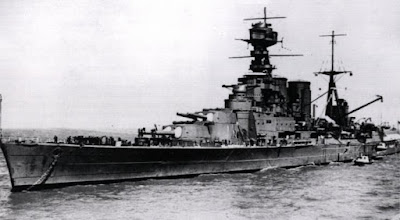USS Tennessee (BB-43) was an American battleship, which was in service with the US Navy between 1920 and 1947. She was severely damaged on December 7, 1941, by Japanese dive-bombers when she was moored at Pearl Harbor naval base. However, she would be repaired and upgraded, taking part in the Island-Hopping Campaign of the Pacific Theater of Operations of World War II as she provided fire support to landing US Marines with her powerful twelve 14-in (356-mm) guns.
USS Tennessee (BB-43) had been laid down on May 14, 1917, at the New York Naval Shipyard, being launched on April 30, 1919. She was commissioned on June 3, 1920, and became the lead ship of her class, which consisted of two battleships, the other being USS California (BB-44). They both were basically a repeat of the New Mexico class, with the exception that they had modern features, such as turbo-electric machinery and had two funnels in contrast to the New Mexico's one funnel. The hull of the Tennessee was flush-sided as they were designed from the start to carry secondary armament at upper deck level.
Right after repair and modernization, USS Tennessee (BB-43) was recommissioned in May 1943. She was assigned to Task Force 1, under Rear Admiral William S. Pye, participating in the major naval operations of the Pacific Theater, such as the Aleutian Island Campaign, the Battle of Tarawa, Battle of Saipan, and Battle of Iwo Jima, as well as the naval battle of Leyte Gulf. After the war, she would serve two more years, being decommissioned in 1947.
Specifications
Type: battleship
Displacement: 32,818 tons (33,150 tons full-load)
Length: 190 m (624 ft)
Beam: 29.7 m (97 ft, 5 in)
Draft: 9.1 m (30 ft, 2 in)
Propulsion: two steam turbine-driven Westinghouse electric generators; four General Electric AC motors, with four shafts, delivering a total of 27,500 shp. The steam turbines were fed by 9 boilers.
Maximum Speed: 21 knots (24 mph)
Range: 8,000 nautical miles (9,200 miles/ 15,000 km)
Armor: 343-mm-thick steel plate on the belt; 330-mm-thick on barbettes (gun emplacement); and 76-mm on deck.
Armament: twelve 14-in (356-mm) naval guns set up in four towers (two fore and two aft); fourteen 5-in (127-mm) guns.
Crew: 1,085
Below, a photo of the Tennessee battleship taken around 1938. You can notice the three Curtiss SOC-3 scout observation biplane aircraft she carried aboard.
The BB-43 in 1921 after she had been commissioned.
Below, the Tennessee under construction at New York Naval Shipyard in 1918.
The mighty battleship right after having been launched. The photo was taken in May 1919.
Below, the USS Tennessee (B-43) anchored in Buckner Bay, Okinawa, in July 1945.









